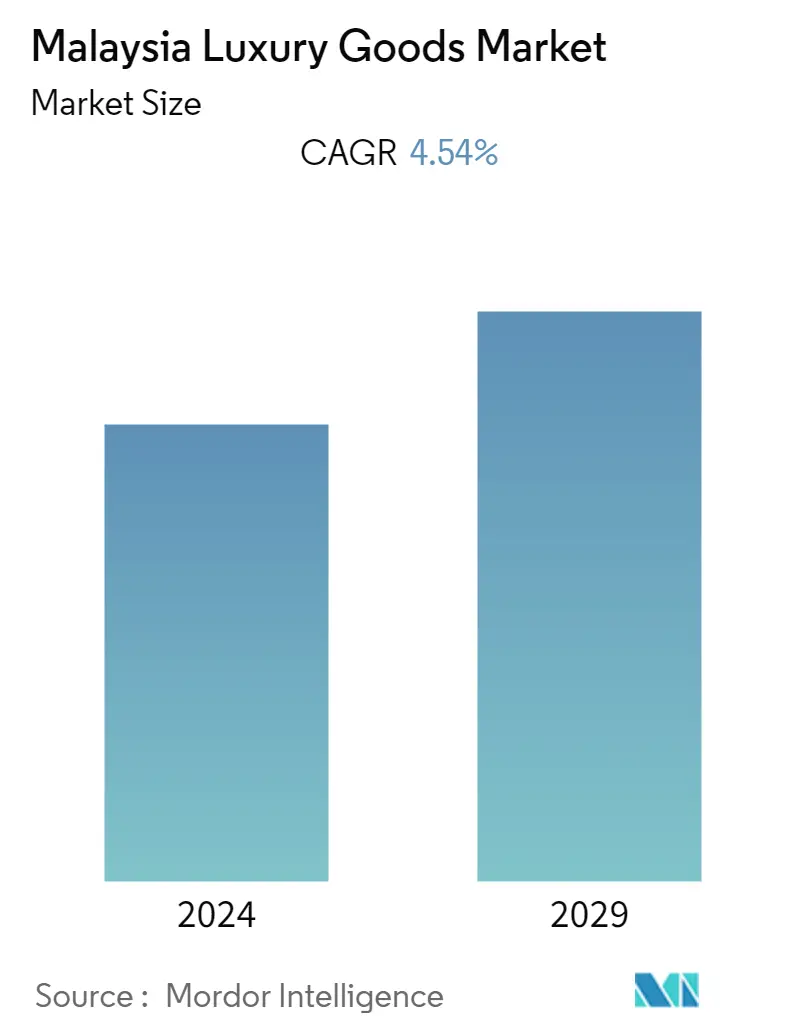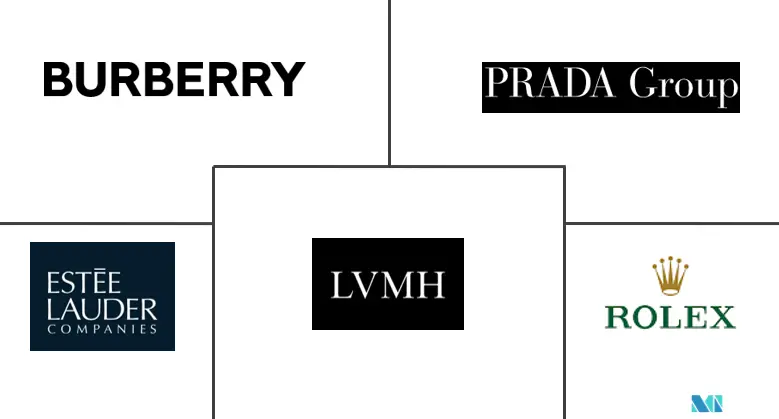Market Size of Malaysia Luxury Goods Industry

| Study Period | 2019 - 2029 |
| Base Year For Estimation | 2023 |
| Forecast Data Period | 2024 - 2029 |
| Historical Data Period | 2019 - 2022 |
| CAGR | 4.54 % |
| Market Concentration | Low |
Major Players
*Disclaimer: Major Players sorted in no particular order |
Malaysia Luxury Goods Market Analysis
Malaysia luxury goods market is projected to grow with a CAGR of 4.54% during the forecast period, 2022 - 2027.
The Covid-19 crisis has hit the luxury and fashion industry hard as the pandemic strongly impacted the way consumers perceive their financial situation. Further, the industry has been affected at different levels of the supply chain by the closure of all commercial markets and malls; and the cross-border trade barriers. Moreover, in 2020 and the early months of 2021, changes in tourism flow due to the ongoing COVID-19 travel restrictions wiped out an undeniably large chunk of the purchasing power. According to the data released by the DOSM (Department of Statistics Malaysia), in 2020, Malaysia recorded a decrease of 83% in international tourist arrival compared to the earlier year due to the pandemic. As most of the tourists are from European countries with significant purchasing power, the pandemic has affected the sales of luxury goods substantially during 2020. However, the pandemic has provided an opportunity for luxury brands in online retailing as techno-savvy consumers are opting for e-commerce platforms to purchase various fashion accessories including footwear, bags, and jewelry, among others.
In the medium term, the demand for luxury products is expected to grow significantly as Malaysia is emerging as one of the popular destinations for luxury tourism, thereby making it a potential marketplace for global luxury brand manufacturers and retailers. Further, the emergence of e-commerce has provided easy access to product-related information and prices, through online sources, at any given point of time. This in turn, expected to accelerate the sale of luxury goods through online retail channels.
Malaysia Luxury Goods Industry Segmentation
Luxury goods are handcrafted with painstaking detail and discipline, featuring extraordinary craftsmanship, and are built with the highest quality materials. The Malaysia luxury goods market is segmented by type and distribution channel. By type, the market is segmented into clothing and apparel, footwear, bags, jewelry, watches, and other accessories. By distribution channel, the market is segmented into single-brand stores, multi-brand stores, online stores, and other distribution channels. The report offers market size and forecasts for Malaysia luxury goods market in value (USD million) for all the above segments.
| By Type | |
| Clothing and Apparel | |
| Footwear | |
| Bags | |
| Jewelry | |
| Watches | |
| Other Accessories |
| By Distibution Channel | |
| Single-brand Stores | |
| Multi-brand Stores | |
| Online Stores | |
| Other Distribution Channels |
Malaysia Luxury Goods Market Size Summary
The Malaysia luxury goods market is poised for growth, driven by the country's emergence as a popular destination for luxury tourism and the increasing influence of e-commerce. The pandemic initially disrupted the market by affecting consumer perceptions and limiting tourism, which significantly impacted sales. However, the shift towards online retailing has opened new avenues for luxury brands, as tech-savvy consumers increasingly turn to e-commerce platforms for their purchases. The market's resilience is further bolstered by the high disposable income of tourists and the presence of multinational brands, which often launch premium products in Malaysia ahead of other markets. This strategic positioning attracts global travelers who contribute significantly to the luxury goods sales, particularly in categories like perfumes and leather products.
The competitive landscape of the Malaysia luxury goods market is characterized by the presence of major multinational companies such as Rolex, Prada, The Estée Lauder Companies, Burberry, and LVMH. These companies leverage a robust distribution network, including single-brand and multi-brand stores, to cater to diverse consumer preferences. Multi-brand stores, in particular, dominate sales due to their wide range of offerings and the ability to showcase private-label products. Strategic initiatives like mergers, acquisitions, and partnerships are common as companies seek to enhance their market presence and brand positioning. The market's growth is also supported by high-income households' preference for luxury gifts, which are seen as symbols of social status, and the ongoing expansion of retail channels, ensuring broad accessibility of luxury goods across the country.
Malaysia Luxury Goods Market Size - Table of Contents
-
1. MARKET DYNAMICS
-
1.1 Market Drivers
-
1.2 Market Restraints
-
1.3 Porter's Five Force Analysis
-
1.3.1 Threat of New Entrants
-
1.3.2 Bargaining Power of Buyers/Consumers
-
1.3.3 Bargaining Power of Suppliers
-
1.3.4 Threat of Substitute Products
-
1.3.5 Intensity of Competitive Rivalry
-
-
-
2. MARKET SEGMENTATION
-
2.1 By Type
-
2.1.1 Clothing and Apparel
-
2.1.2 Footwear
-
2.1.3 Bags
-
2.1.4 Jewelry
-
2.1.5 Watches
-
2.1.6 Other Accessories
-
-
2.2 By Distibution Channel
-
2.2.1 Single-brand Stores
-
2.2.2 Multi-brand Stores
-
2.2.3 Online Stores
-
2.2.4 Other Distribution Channels
-
-
Malaysia Luxury Goods Market Size FAQs
What is the current Malaysia Luxury Goods Market size?
The Malaysia Luxury Goods Market is projected to register a CAGR of 4.54% during the forecast period (2024-2029)
Who are the key players in Malaysia Luxury Goods Market?
Rolex S.A., Prada S.p.A, The Estée Lauder Companies Inc., Burberry Group PLC and LVMH Moët Hennessy Louis Vuitton are the major companies operating in the Malaysia Luxury Goods Market.

